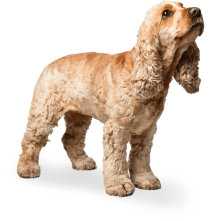

Dog skin allergies
From mild irritation to more persistent signs, dog skin allergies are surprisingly common – and something many owners find themselves trying to manage at some point. Whether your dog has started scratching more than usual or you’re just curious to learn more, we’re here to help you understand the causes of skin allergies in dogs, how to spot the signs, and simple steps that can help support their comfort.
Dog skin allergy signs
Every dog is different – and so are the signs of a skin allergy. For some, the signs might be subtle. For others, they can impact day-to-day life. Here's what to look for:
- Itching or excessive licking
- Red, sore or inflamed skin
- Rashes or bumps on the skin
- Hair loss or thinning fur
- Ear scratching or frequent head shaking
- Restlessness, lower energy or seeming unsettled
In some cases, you may notice signs that look like an allergic reaction on dogs’ skin – especially after contact with a particular material, or an insect or flea bite. If your dog has swelling around the face or mouth, or seems to be struggling with breathing or walking, it’s important to contact your vet straight away.

Causes of skin allergies in dogs
Just like humans, dog skin allergies can be caused by a wide range of environmental or dietary factors. These are often referred to as allergens for dogs, and can include everyday things like pollen, fleas or even the material in your dog’s bed.
Here’s a closer look at some of the most common triggers.
Flea allergies in dogs
Fleas bites can be irritating for our dogs and can cause itching and inflammation, but did you know some dogs can also be allergic to fleas?
If your dog with itchy skin is licking, scratching or showing red patches, it’s worth checking for fleas. You may not always spot the fleas themselves, but signs like flea dirt (tiny dark specks) in their coat can be a useful clue.
To learn more, take a look at why does my dog keep itching. For support at home, regular, appropriate flea control for all pets – and treating your home environment – can help manage ongoing concerns.
Pollen allergies in dogs
Just like us, dogs can also react to pollen. These reactions can happen all year round but tend to spike in spring and summer. If your dog seems itchier after a walk, or frequently rolls in grass, pollen could be playing a part.
Washing or wiping down paws and coats after walks can help limit exposure. During high pollen days, try walking in the early morning or evening when levels are lower.
Food allergies in dogs
Food sensitivities are another possible cause of allergic reaction in dogs – particularly when signs are ongoing or seem to appear unpredictably. In many cases, dogs can react to ingredients they’ve been eating for a long time rather than something new.
Common allergens for dogs can include animal proteins and also some carbohydrates. If you’re noticing changes in your dog’s digestion or behaviour after meals, it might be time to consider a new approach. Keeping a food diary and speaking to your vet about a diet trial can be a helpful step in understanding what’s going on.
For more on digestive signs, take a look at our guide to upset stomach in dogs.
Atopy in dogs
Atopic dermatitis is a skin concern that can be very uncomfortable for dogs, often making them feel extremely itchy. It usually becomes noticeable in young dogs between around six months and three years old, but can sometimes develop later in life.
Although not yet fully understood, atopy is thought to have a genetic link, as certain breeds may be more prone to developing it.
Dogs with atopy often show signs like head shaking, paw licking, face rubbing, or reacting to allergens such as dust or grass.
It may take time for these signs to show a pattern, and vets often recommend ruling out other potential causes such as fleas or food before settling on atopy. Controlling other potential allergens can also help control the atopy. There’s no single test for atopy, but by keeping a close eye on your dog and making a few simple adjustments, you can help find the right support for them.
How to help dog allergies
Wondering how to help dog allergies? Every dog is different, but here are a few helpful approaches that could support their comfort:
- Try gentle dog skin supplements with Omega-3 and 6 fatty acids
- Use specially formulated shampoos for sensitive skin
- Keep their coat and paws clean after walks
- Speak to your vet about hypoallergenic diets
- Ensure regular, year-round flea control
- Create a calm, clean living space with fewer triggers
If your dog’s scratching, licking or skin irritation isn’t improving, a chat with your vet is always a helpful next step. Read our tips on how to support your dog with dry skin this summer.
Small changes can have a big impact
Dog skin allergies can affect dogs of all ages and breeds – but with the right understanding and support, you can help them feel more comfortable day to day. Often, it’s a combination of small changes that work together to make the biggest difference, helping to manage allergies more effectively.
From spotting early signs to reducing exposure to allergens for dogs, even small adjustments can have a positive impact on your dog’s wellbeing.


